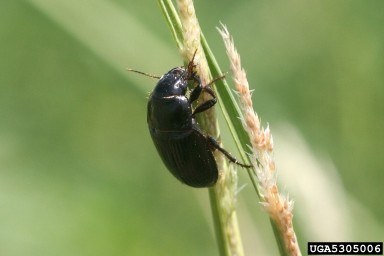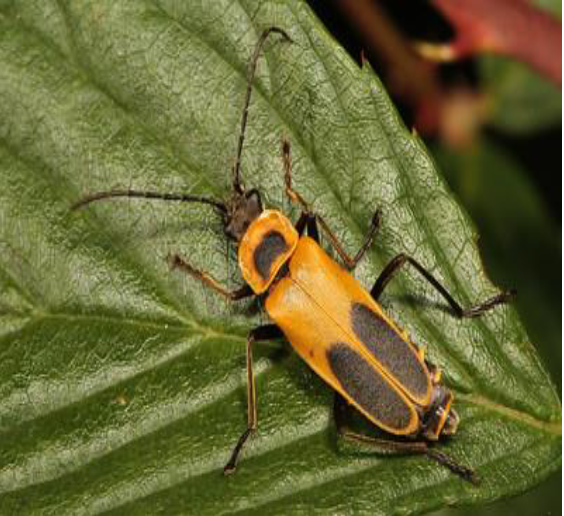Posted: June 15, 2023
Often when we think of beetles, the first thing that comes to mind is pests – cucumber beetles eating our cucumbers, asparagus beetles eating our asparagus, and Japanese beetles eating everything else! But many beetles play a crucial, beneficial, and often thankless role in the ecosystem. Read more to learn about beetles ecological contribution to the environment.

Ground Beetle by W.Cranshaw, bugwood.org
Beetles Ecological Contribution:
Beetles are an incredibly diverse group of insects that make up the largest order in the animal kingdom, Coleoptera. Well over 300,000 species have been recorded by scientists, representing about 40 percent of known insects and roughly 25 percent of all known animals on Earth. Beetles have a long history on this planet and are the oldest known pollinators of flowering plants: fossil records show they coexisted with dinosaurs during the Mesozoic Era, roughly 200 million years ago. Beetles play an important ecological role both as predators of pests and as pollinators. Many beetles, such as lady beetles and predaceous ground beetles, are helpful garden companions because they provide beneficial pest-control services. Other beetles, such as soldier beetles, longhorned beetles, sap beetles, and checkered beetles, all provide important pollination services in the garden and beyond.

Beetles' Life Cycle:
Beetles undergo complete metamorphosis, meaning that their life stages consist of egg, larva (including several instars, or developmental stages between successive molts), pupa, and winged adult. The length of the life cycle varies from species to species; certain wood boring beetles and scarab beetles may take 2-5 years or more, while other beetles may have several generations each year. Some species, such as lady beetles, have similar feeding habits as both larvae and adults. In other groups, the larvae and adults do completely different things. For example, blister beetle larvae are parasitic on soil-dwelling insects, but the adult beetles feed on plants. Beetles often lay their eggs among decaying leaves, rotten wood, and even animal feces. Some beetles keep their eggs inside their bodies and give birth to live larvae. Eggs are usually deposited in small clusters near food sources for the young larvae.
In their larval stage, beetles are often referred to as "grubs" or "worms." While adult beetles usually feed on exterior parts of the plant such as leaves, stems, or flowers, larvae may feed on internal parts of the plant, such as the roots, as well as on the outside of the plant. After a beetle has gone through its larval stage, it will form a pupa, somewhat similar to the way a butterfly forms a chrysalis. While in this form, the beetle does not eat or move very much while its insides rearrange into the form needed for its adult stage.

Beetle Pollinated Plants:
Flower-visiting beetles are mostly interested in protein-rich pollen, rather than nectar, as a food source. They are sometimes referred to as "mess and soil pollinators" because they may eat through leaves and petals, leaving small holes, bits of plant matter, and frass in their wake. Many pollinator beetles are hairy, allowing for pollen grains to stick to them and be transferred among plants. Beetle-pollinated plants have evolved to have thicker flowers and leaves to survive this feeding damage by beetles.
Beetle-pollinated plants share several other common traits. These include large, cup-like flowers that are typically open during the day; heavily scented blossoms; and leathery or tough petals and leaves. Although beetles do have color vision, they rely primarily on their sense of smell to find flowers. People tend to describe flowers pollinated by beetles as spicy, sweet, musky, or fermented like overripe fruit.
The classic example of a beetle-pollinated plant is a magnolia, a tree that has been evolving along with beetles for millions of years. Other examples include tulip trees (Liriodendron), pawpaw (Asimina), sweetshrub (Calycanthus), and water lilies (Nymphaeaceae). But beetles are not limited to these ancient trees that evolved along with them. They are found visiting a wide variety of flowering plants, particularly those that produce clusters of smaller flowers like goldenrod (Solidago), spirea (Spiraea), spicebush (Lindera), yarrow (Achillea), sunflower (Helianthus), and wintersweet (Chimonanthus). Beetles also frequent flat to dish-shaped or bowl-shaped flowers, as these features provide them an easy platform for landing and often a good place for shelter.
Many beetles, including soldier beetles, mate in the same flowers they visit for food. Predatory beetles, such as lady beetles, also hide in flowers, waiting for soft-bodied insects to visit. Beetles may also use flower blooms as a place to hide from predators. Some beetles may even enter flowers because the temperature within their blossom is preferable to external environmental conditions. Generally, beetle pollinated flowers are able to offer an additional incentive or several to get beetles to come and stay awhile.

Declining Beetle Populations - Causes and Consequences:
As with other species of insects, beetle populations are declining due to habitat loss and fragmentation, pesticides, climate change, and potentially light pollution and disease. In 2019, Biological Conservation reported that 40% of all insect species are declining globally and that a third of them are endangered. This rate of extinction is eight times faster than that of mammals, birds, and reptiles. A recent study using research models developed by NASA found that due to extreme changes in temperatures, 65 percent of the 38 insect populations studied could face an increased risk of extinction over the next 50 to 100 years. Temperature changes are particularly threatening for insects because these cold-blooded creatures are not able to regulate their body temperature during drastic temperature swings.
This stark decline in the insect population, including beetles, spells trouble for humans. At a time when insect numbers are plummeting, human agriculture that depends on insect pollination is increasing exponentially. The UN has warned that this is a food security issue, not only because of the pollination services insects provide but also because of their crucial role in building and maintaining soil structure - something beetles contribute to by processing decaying organic matter.
As Penn State Master Gardener Lorena Koszarek. has observed, "To help protect all our pollinators, the volunteers of Penn State Extension Master Gardeners of Monroe County have created a habitat restoration demonstration garden, called Project NatureScape, that provides a welcoming habitat for bees, butterflies, moths, wasps, flies, and beetles." The garden features native plants that support various pollinators. It also features various garden beds that the average person can incorporate into their home landscapes.
The mission statement of Project NatureScape is - "Learning from the past, taking action in the present, and protecting the future." This garden aims to teach the public to understand the importance of providing all our pollinators a safe habitat so that they can continue to pollinate the plants that both humans and animals depend on. Stop by Project NatureScape to see these pollinators in action and get some ideas for your own yard!
How Gardeners, Homeowners, and Others Can Help:
You can help address this crisis by providing habitat for beetles to carry out their egg laying and hunting, sheltering, and overwintering. You can do this by:
- Planting a diversity of species appropriate for your area that appeal to beetles and other wildlife. This might include plants like sunflowers, goldenrods, and spicebush.
- Providing shelter for beetles by including a mixture of features like perennials, ground cover plants, dead leaves or other plant material, and some areas of bare soil. Some species may live for several years and require sheltered overwintering sites such as perennial plants or clumps of grasses.
- Eliminating the use of insecticides, which can directly kill beetles and other insect pollinators, as well as herbicides that will eliminate the plants that provide their food and shelter. Plants treated with systemic insecticides can produce toxic pollen and nectar which may harm pollinating insects. When purchasing seeds and plants, ask the seller whether they are organic or pesticide-free stock.
- Not buying and releasing lady beetles (sometimes called ladybugs). This practice harms native lady beetles at collection sites, may harm local populations at release sites and is not effective at helping control local pest species.
- Protecting soil health--plant cover crops, use mulch for weed control, leave the leaves, and add compost to build and protect soil organisms including beetle eggs and larvae.
- If possible, provide a steady source of water or moisture, or create shady spaces that will help retain moisture.
- Finally, you can do what you can to help address the crisis of climate change, which poses an existential threat to beetles among so many other species on Earth.
Article by Brenna Rabinowitz, Penn State Master Gardener, Monroe County
Sources:
USDA: Beetle Pollination
Xerces Society: Notes from the Other Orders: Beetles as Pollinators
Xereces Society: endangered Beetles
University of Maryland: Beetles and Pollination
University of Wisconsin Extension: Beetles
University of Kentucky: Insects with a Complete Life Cycle
Penn State Extension Master Gardener Program: Beneficial Insects in the Garden
NASA: Climate Change Can Put More Insects at Risk of Extinction
NPR: The world's Insect Population Is in Decline- and That's Bad News For Humans
UNEP.org: Insect Declines Are a Stark Warning to Humanity
Texas A&M Extension Entomology: Lady Beetles
Photo Credits: Wikipedia Commons; Negativespace

